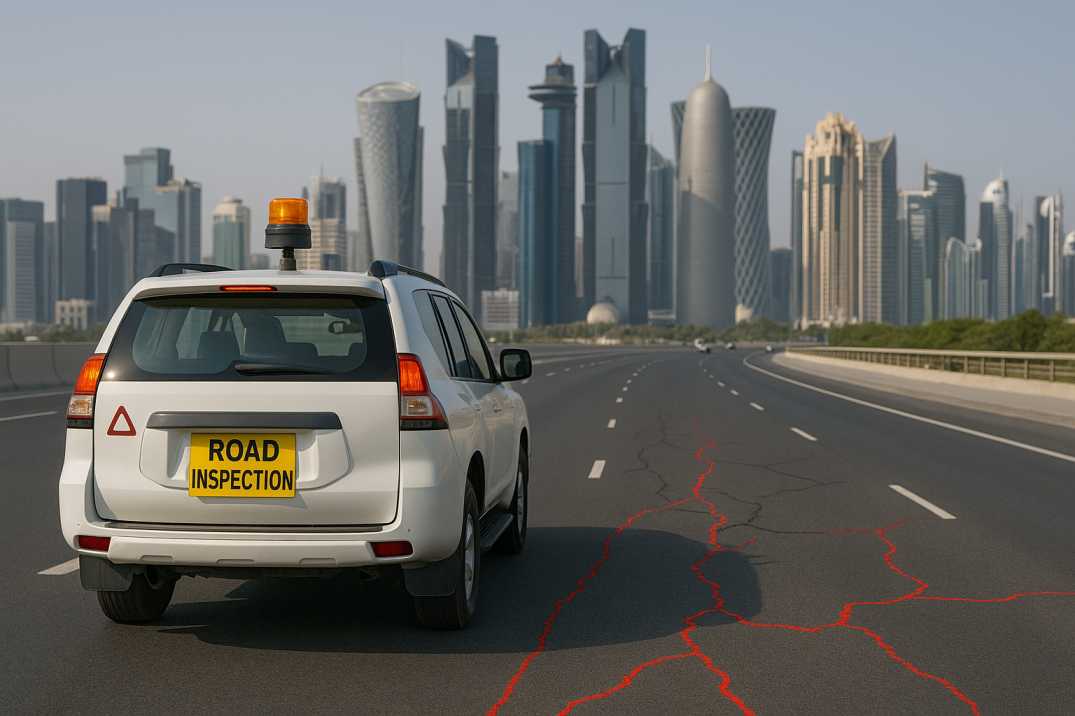Contact Us
RoadVision AI
Private Limited
Office No. 308 & 310, B Block
Ansal Chamber - 1, Bhikaji Cama Place,
Near Engineers India Limited (EIL) Bhawan, New Delhi - 110066
© 2024 | RoadVision AI | All rights reserved
As Qatar continues investing in world-class infrastructure aligned with Qatar National Vision 2030, the demand for intelligent, data-driven pavement maintenance systems has never been greater. In a region where roads are exposed to intense heat, heavy logistics traffic, and evolving urban development, predictive maintenance for pavement in Qatar is not just beneficial—it is essential.
This is where AI-based road asset management offers a powerful solution. By leveraging video analytics, machine learning, and automated defect detection, agencies like Ashghal (Public Works Authority) and private contractors can now forecast pavement failures well before visible deterioration occurs. This proactive approach reduces maintenance costs, avoids unsafe conditions, and extends pavement life.
In this blog, we explore how AI road failure forecasting works, what pavement lifecycle modeling in Qatar involves, and how RoadVision AI helps infrastructure authorities stay ahead of the curve.

Qatar has invested billions in developing arterial roads, expressways, and mega-infrastructure projects across Doha, Lusail, Al Khor, and the northern municipalities. These assets face challenges such as:
According to Ashghal’s Highway Design Manual and the Road Asset Management Manual, routine and reactive maintenance alone cannot meet the country’s long-term infrastructure durability goals.
That is where predictive maintenance pavement Qatar strategies, powered by AI, provide a more sustainable alternative to traditional methods.
AI road failure forecasting uses automated tools to analyze road imagery, classify pavement distress, assess severity levels, and model how those issues will evolve over time.
This process typically includes:
With these insights, authorities can implement a preventive maintenance regime, preserving road conditions and optimizing repair budgets.
Here are key advantages for Qatari road authorities using AI road asset management:
AI identifies micro-cracking and surface deformations invisible to human inspectors, allowing interventions before they escalate into structural failures.
By understanding when and where a road will fail, agencies can better estimate repair costs, leading to efficient pavement lifecycle modeling in Qatar.
AI enables targeted maintenance, minimizing unnecessary work zones and ensuring safer, smoother mobility across the national road network.
Ashghal’s Asset Management Strategy emphasizes data-backed maintenance plans and optimized interventions—goals that AI can achieve reliably and cost-effectively.
At RoadVision AI, our platform provides cutting-edge tools for pavement condition forecasting, asset digitization, and road lifecycle planning tailored to GCC infrastructure needs.
RoadVision has already partnered with multiple public and private stakeholders in AI road asset management projects across the Middle East, showcasing measurable cost savings and operational efficiencies. You can view these success stories in our Case Studies.
This automation drastically improves over manual methods, where inspectors often rely on visual estimates and limited sampling.
Integrating traffic surveys with pavement distress forecasting gives a 360-degree view of pavement stress factors.
For example, if a segment shows early signs of cracking and is located on a high truck-volume route, RoadVision’s model can recommend strengthening overlays well before full pavement failure occurs.
As Qatar accelerates toward digital infrastructure and smart asset management, AI road failure forecasting is no longer a futuristic concept—it is a present-day necessity. Whether managing city streets or mega expressways, predictive maintenance pavement Qatar strategies powered by AI road asset management platforms are the key to long-lasting, resilient, and cost-efficient infrastructure.
RoadVision AI is leading innovation in AI in road maintenance, providing a smart, automated solution for managing road networks. It conducts detailed traffic surveys and generates high-quality road data for early detection of issues such as surface cracks and the need for potholes repair. This technology-driven platform brings the power of AI in road planning and monitoring to enhance road safety. With a mission to create smarter, safer, and more sustainable roads, RoadVision AI ensures full compliance with IRC Codes as well as Qatar’s road design and maintenance standards set by Ashghal and MoTC. The platform empowers engineers and infrastructure stakeholders to make data-driven decisions that reduce costs, minimize risks, and enhance the overall transportation experience across both Indian and Qatari networks.
With tools like RoadVision AI, Qatar’s road agencies can move from reactive fixes to data-driven prevention.
Ready to see it in action? Book a demo with us to explore how RoadVision can transform your pavement maintenance strategy.
Q1. How does AI predict road failures in Qatar?
AI uses visual pavement data and historical patterns to model how cracks and surface issues evolve over time, offering failure forecasts before they happen.
Q2. What standards does Qatar follow for pavement maintenance?
Ashghal follows localized standards derived from global best practices including PCI, IRI, and lifecycle-based rehabilitation planning.
Q3. Can RoadVision AI be used on secondary roads or internal city roads?
Yes, RoadVision AI works effectively on urban, rural, and arterial roads using just a smartphone or dashcam setup.